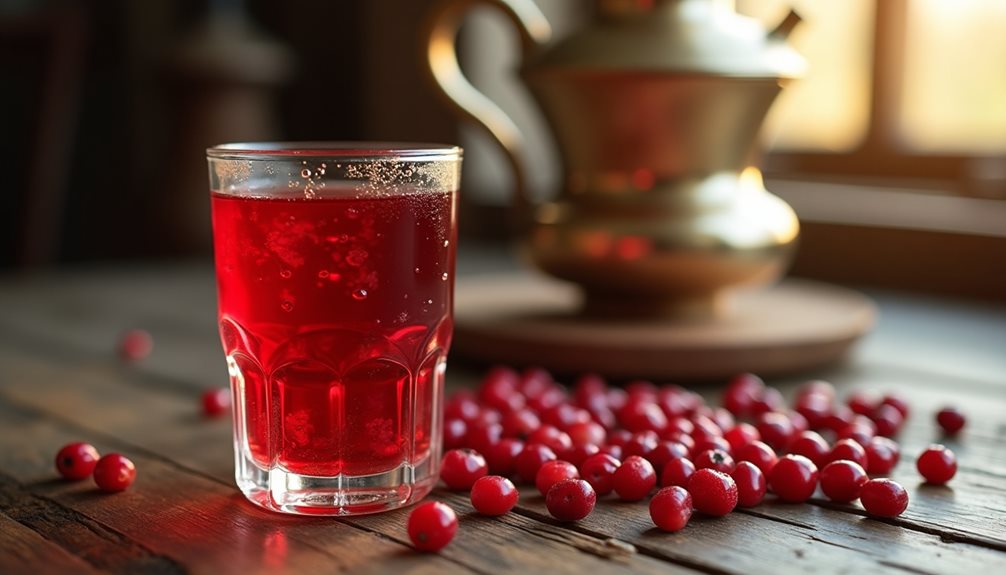Mors is more than just a beverage; it embodies the essence of Russian summer. This traditional drink, crafted from red currants and raspberries, offers a unique blend of invigorating flavors and numerous health benefits. As the vibrant colors and tantalizing taste invoke memories of sun-soaked days, the process of making mors reveals its rich cultural significance. Discovering the history and preparation of this delightful drink may inspire a new appreciation for a timeless favorite.
The History of Mors

Mors is more than just a refreshing drink in Russia—it’s a symbol of hospitality, family, and tradition. While the exact story of its invention is unclear, written references to mors date back to at least the 16th century. For centuries, it has remained a staple in Russian homes, celebrated for its simple ingredients and unmistakable taste.
Mors has found its way into Russian folklore and literature, often symbolizing the abundance of nature or setting the scene for festive gatherings. Writers and poets have used it to evoke nostalgia and rural simplicity, while in fairy tales, the berries that make up mors are gifts from the forest—signifying both generosity and the deep connection between people and their landscape.
In contemporary Russia, mors is quietly enjoying a revival. Artisanal cafés in cities like Moscow and St. Petersburg now offer inventive takes on traditional mors, sometimes mixing in spices or unusual berries to create new flavors. Trendy restaurants serve it alongside modern cuisine, blending rustic tradition with urban style and proving that mors adapts beautifully to changing tastes.
The appeal of mors isn’t limited to Russia. Similar berry drinks are enjoyed across Eastern Europe, including Ukraine, Belarus, Poland, Latvia, and Lithuania—each culture putting its own spin on the classic drink. This shared tradition highlights how mors acts as a common thread running through diverse Slavic communities.
Though many associate mors with summer refreshment, it’s also a winter comfort. During colder months, mors is often served warm, occasionally infused with cinnamon or cloves for a cozy twist. Its versatility makes it a staple throughout the year, not just when berries are in season.
For generations, mors has also been valued in Russian folk medicine. Healers have recommended it as a remedy for colds, fatigue, and general malaise, appreciating its natural ingredients and restorative properties. It’s more than a thirst-quencher—it’s part of a holistic approach to wellness that persists today.
The process of making mors often starts with berry picking, another cherished tradition. Families head to forests or gardens during the berry season, turning the harvest into a social event that strengthens community bonds and keeps old customs alive. These outings are about more than gathering ingredients; they are moments of connection with nature and each other.
Mors even appears in art and popular culture—vintage Soviet posters and children’s stories feature it as a symbol of wholesome living alongside bread, honey, and fresh fruit. These images reinforce its status as an emblem of Russian identity and homegrown goodness.
At its heart, mors is a celebration of simplicity and sustainability. The drink is made using every part of the berry, sometimes even adding leaves to enhance the flavor, reflecting an age-old respect for natural resources and minimal waste.
All these layers—literary references, modern reinventions, ties to nature, and sustainable practices—show that mors is much more than a beverage. It’s a living tradition woven into daily life, art, health practices, and cultural memory across Russia and beyond.
![]()
What is Mors?
Mors is a fruit drink made by mixing the juice of fresh or sometimes frozen berries—typically cranberries, lingonberries, or blackcurrants—with water and a bit of sugar or honey. The berries are lightly simmered or pressed to release their juice, which is then diluted and sweetened to taste. Unlike many Western fruit drinks, mors is rarely carbonated and doesn’t contain artificial flavors or preservatives.
Historically, mors has been served during holidays, family feasts, weddings, and summer festivals. Its deep red color and tart flavor make it especially popular during the hot months as a natural way to cool down. In the colder seasons, it provides a welcome dose of vitamins when fresh fruits are scarce.
Across Russia, each region has put its own spin on mors. In the northern forests, wild lingonberries or bilberries are common. In the south, people might use cherries, raspberries, or strawberries. Some families add herbs like mint or lemon balm for extra aroma. Others experiment by blending several berries together, creating unique flavors that reflect local landscapes and tastes.
Health Benefits of Enjoying Mors
Mors, a traditional Eastern European berry drink, offers more than just a delicious, refreshing taste—it’s packed with health benefits thanks to its simple, natural ingredients. Made from berries such as red currants, cranberries, and raspberries, mors is naturally rich in antioxidants like vitamin C and flavonoids, which help protect the body from harmful free radicals and support overall health. The vitamin C content also strengthens the immune system, helping the body fight off infections and recover faster from illnesses.
In addition to its immune-boosting properties, mors supports digestive health due to the natural acids and dietary fiber found in berries. Drinking mors can gently stimulate digestion and contribute to a healthy gut. Its hydrating qualities make it an excellent choice for quenching thirst, especially on hot days or after exercise. Unlike many sugary soft drinks, mors can be prepared with little or no added sugar, making it a healthier beverage option that’s lower in calories.
Berries used in mors are also good for heart health, as compounds like anthocyanins have been shown to help reduce blood pressure and improve blood vessel function. If you choose cranberry mors, you may also benefit from its reputation for promoting urinary tract health by preventing bacteria from sticking to the urinary tract lining. Beyond its physical benefits, the vibrant color and naturally sweet-tart flavor of mors can be uplifting, and the B vitamins found in berries support the nervous system and overall mood.
All these factors combine to make mors a wholesome drink that’s as nourishing as it is enjoyable. Whether you’re looking for an immune boost, a tasty way to hydrate, or simply a refreshing treat, mors is a wonderful choice for supporting your well-being.
![]()
Mors: From Palaces to Home Tables
Mors, a traditional Russian berry drink, has a story that stretches from the grandeur of imperial courts to the bustle of modern city life. In the days of the Russian Empire, mors graced the tables of nobility and even the tsars themselves. It was often served in ornate glassware alongside multi-course feasts, valued not only for its taste but also as a symbol of hospitality and abundance.
The drink is typically made by mixing freshly squeezed juice from berries—most commonly cranberries, lingonberries, or black currants—with water and sweetener. Sometimes honey is added, or even a hint of lemon for extra zest. In the past, berries were foraged from wild forests or cultivated in palace gardens, ensuring that only the finest ingredients made it to the tsar’s table.
As time passed, mors became a beloved staple across Russia. Its appeal lies in both its refreshing flavor and its health benefits: rich in vitamin C and antioxidants, mors is believed to boost immunity and refresh the palate. Today, you’ll find mors everywhere—from homemade pitchers in rural dachas to chic Moscow cafés serving it in tall glasses over ice. Mass-produced versions are now available in supermarkets and convenience stores throughout Russia and neighboring countries.
Despite its availability in stores, many Russians still cherish the tradition of making mors at home. The process is seen as an art passed down through generations—grandparents often invite their grandchildren to help pick ripe berries, teaching them how to balance sweetness and tartness just right. These moments are not only about preparing a drink but also about sharing stories and preserving family rituals.
Mors remains central to Russian celebrations, whether it’s a summer picnic in a birch grove or a winter holiday feast. It is often preferred over sugary sodas or artificial juices, prized for its natural ingredients and deep connection to Russian heritage. The drink’s vibrant color and tangy flavor evoke memories of childhood and family gatherings, strengthening bonds between young and old.
In essence, mors is more than just a beverage—it’s a living link to Russia’s past, a symbol of togetherness, and a taste of home that continues to unite people across generations and social classes.
![]()
A Symbol of Russian Hospitality
In Russian culture, offering a glass of mors—a traditional berry drink—to guests is much more than simply serving a beverage; it is a time-honored gesture of welcome and respect. Historically, when visitors arrived at a Russian home, they were greeted with mors as a sign of warmth and generosity. This custom reflects the deep-rooted value Russians place on hospitality, where making guests feel comfortable and cared for is of great importance.
Mors is usually made from local berries such as cranberries, lingonberries, or blackcurrants, mixed with water and a touch of sugar. Its refreshing, slightly tart flavor is enjoyed both in summer and winter. Sharing mors is not just about quenching thirst—it’s about creating a moment of connection. The act of pouring and offering this drink to someone communicates friendship, goodwill, and an open heart.
For foreigners experiencing Russian hospitality, being served mors is an invitation to feel at home. It’s a simple tradition, yet it carries centuries of meaning, reminding everyone at the table that hospitality is at the heart of Russian culture.
Mors endures not just as a drink, but as a living symbol of Russian heritage—one that bridges generations and connects city dwellers with their rural roots. Its story is told in berry-stained hands, in family gatherings under birch trees, and in the quiet moments when a glass of ruby liquid offers comfort against the chill of winter. Whether served at an imperial banquet or poured from a homemade pitcher in a small kitchen, mors carries with it centuries of tradition, hospitality, and resourcefulness. In every sip, there’s a taste of the landscape, the memory of shared rituals, and the ongoing creativity of those who keep the custom alive. Mors invites anyone who tries it to join in a uniquely Russian experience—one that’s both refreshingly simple and rich with meaning.




